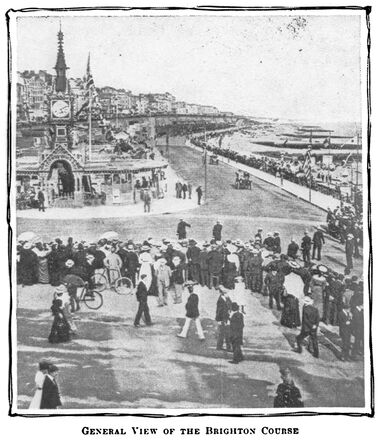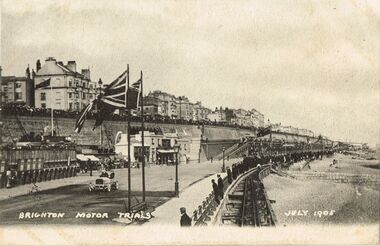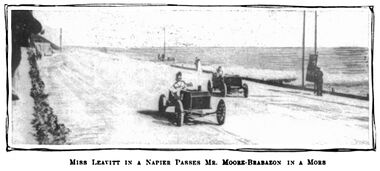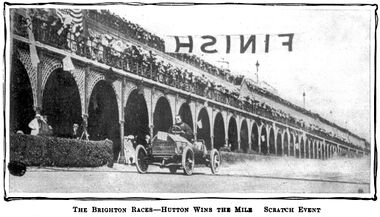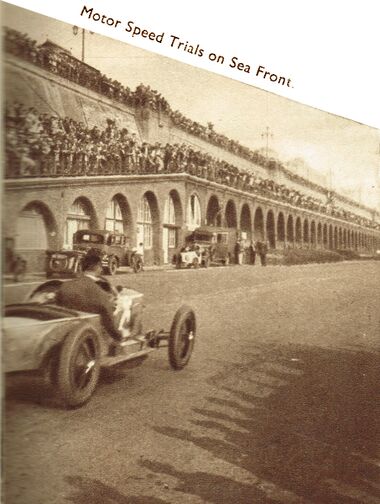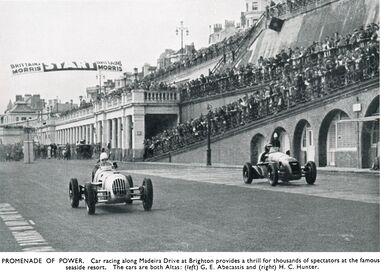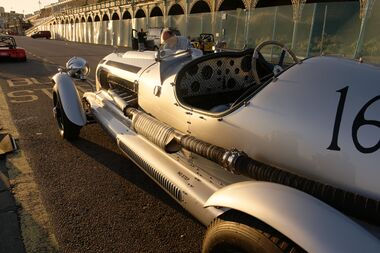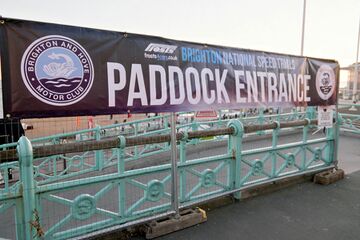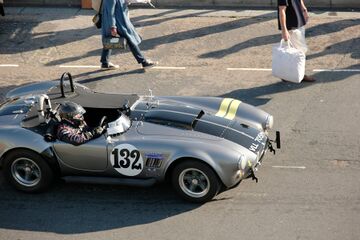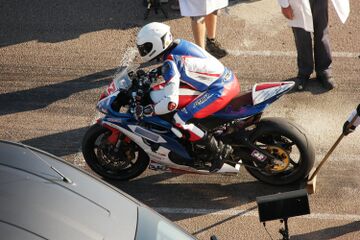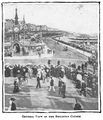Category:Brighton Speed Trials
1905: General View of the Brighton Course [image info]
1905: The first July 1905 Motor Trials [image info]
1905: Dorothy Levitt, driving a Napier [image info]
1905: John Ernest Hutton passes the finish line and wins the Mile [image info]
1935: Brighton Speed Trials, in the Corporation Handbook [image info]
1938: "PROMENADE OF POWER. Car racing along Madeira Drive at Brighton provides a thrill for thousands of spectators at the famous seaside resort. The cars are both Altas: (left) G. E. Abecassis and (right) H. C. Hunter." [image info]
2018: Rolls-Royce Merlin-engined Handlye Special. Yes, that's a Spitfire engine. [image info]
The Brighton Speed Trials, held at Madeira Drive, Brighton, are supposed to be the oldest and longest-running motor speed trial event in the world, and consist of a "quarter-mile sprint" along the seafront road.
The Motor Sports Association (MSA) are responsible for the event, Brighton and Hove Motor Club (BHMC) organise the main car section of the trials, and entering motorbikes into the "two-wheeler" part of the event is done via the Vintage Motor Cycle Club (VMCC)
The Speed Trials usually take place on the second Saturday of September, but not always: in 2018 they took place on Saturday September 1st.
History
Madeira Drive was considered a perfect venue in 1905 for speed trials – as an entirely artificial surface, built on stone, to prevent the sea from reaching and undermining the seawall, it was long, flat, straight, ultra-stable, it could be sealed off from general traffic without causing any trouble, there were no adjacent houses and few adjacent businesses ... and as it was owned by the Council rather than being a public highway, it was arguably a private road, and therefore immune to the 20mph speed limits imposed by the Motor Car Act 1903.
The idea that anyone else would spend a substantial amount of money to build a long, straight section of stone-foundationed private road that wasn't actually needed for traffic, and was also conveniently overlooked by terraces capable of holding thousands of onlookers was highly improbable, all that was needed was for the road to be coated with the exciting new new "tarmacadam" or "tarmac" road-surface material (patented by Edgar Purnell Hooley in 1902), and it would be ideal for speed trials.
Sir Harry Preston made the case to the town council that tarmac-ing the road (not called Maderira Drive until ~1909) would make it suitable for public road-racing events, they agreed, and the first Speed Trials took place in July 1905.
1905 report
NEW MARKS MADE AT BRIGHTON
London, July 25 — As a result of the 4 days of racing at Brighton, one world’s record and one British mark were shattered by the automobiles, while four new world’s motor cycle records were created. Lee Guinness, in a 100-horsepower Darracq, did a standing kilometer in 35 4⁄5 seconds, a pace of 62.48 miles an hour, while Clifford Earp, in a 90-horsepower six-cylinder Napier, created a fresh British mark for the flying kilometer when he did 23 seconds, a 97.25 mile an hour clip. In the motor cycle division Cissac and Rignold divided the honors, the former breaking the standing mile, doing 53 1⁄5 seconds and the flying kilometer in 26 seconds, riding a 12-horsepower Peugeot, while Rignold, on the same make of machine, covered the flying mile in 46 3⁄5 seconds, a rate of 71 miles an hour, and the standing kilometer in 36 1⁄5 seconds. Another interesting feature of the meet was a clash of automobiles and motor cycles, in the special races, the automobiles winning in each instance, but only by the narrow margins of 2⁄5 and 3⁄5 seconds respectively.
Britons got a real taste of racing similar to that enjoyed at Ormond, Ostend and Dourdan at the Brighton meeting. It cost the town something like $20,000 to fix up the Madeira road for racing purposes, but the meet was so successful that the mayor and the corporation are not begrudging a penny spent for the motorists and the racing.
Motor cars were greatly handicapped by the shortness of the course. At first the start of the standing mile allowed of 30 yards of downhill run, but when it was found that even the big cars could pull up without difficulty the full mile was measured on the flat. It was impossible to try flying miles and even in the kilometer trials the cars found difficulty in avoiding accidents, so Earp’s 23 seconds is considered extra good.
Madeira road was bordered along the north by a high retaining wall, which afforded sightseeing facilities for thousands of spectators. Midway between the track and the upper road was a lengthy terrace, from which an extensive view of the whole course could be had. This was used by the Automobile Club of Great Britain for its members and invited guests. Favored by magnificent weather all 4 days, record-breaking crowds were out, it being estimated that the daily attendance averaged between 15,000 and 20,000. Attempts were made to bring about close finishes, but this failed, although many of the events were for cars of the same make. Despite this, even with twin cars, the finish was straggling. Handicapping, too, proved a fizzle, but nevertheless the racing was enjoyed by thousands of onlookers.
One new car was seen — a 100-horsepower Rochet-Schneider, which Theodore Schneider brought direct from the factory, not even stopping to tune up the machine. As a result he failed to get the anticipated results, although he was praised for his sportsmanlike conduct in not scratching his car from the races. There was a 150-horsepower Dufaux exhibited, a weird looking monster with festoons of cooling pipes hanging all around its cylinders. It had a bore and stroke of no less than 50 by 225 respectively. C. S. Rolls was unable to start the car at first, because the engine could not be made to fire. Attempts were made to start it by towing it to the starting line while in gear. Finally the car got over being balky, but all the way down the road it backfired, roaring at the same time, producing a noise which resembled artillery practice. Its best work was 1 minute 3 2⁄5 seconds for 30 yards short of 1 mile. The best performance for the standing mile was 45 1⁄5 second by Earp.
On the first day, Wednesday, the scratch race for standard 15-horsepower Darracqs was won by H. Kennedy by 5 4⁄5 seconds over H. E. Hall. W. W. Genn won the tourists’ motor cycle handicap, on a Minerva. E. W. Lewis, in an 8-horsepower Rover, took the scratch race for cars not exceeding $1,000 list, with two passengers. J. Keele, in a 15-horsepower Darracq, won the scratch race for cars with chassis price of over $2,000 and not over $3,000. G. H. Warne, in a 28-horsepower Daimler, captured the scratch race for cars with chassis price over $3,500 and not over $4,000, Miss Godwin was a close second in an Ariel Simplex, being beaten by only 4⁄5 second. J. M. Gorham took the event for 30-horsepower Daimlers, Clifford Earp won the feature race of the day from J. E. Hutton in 47 3⁄5 seconds. Earp drove a 6-cylinder Napier car in the event.
Thursday saw Cissac's record performance on a motor cycle. The scratch race for cars of $1,000 to $1,500, those not more than $1,250 carrying two passengers only, went to L. Coatalen in a 10-horsepower Coventry Humber. E. W. Lewis, in a 16-horsepower Rover, scored in the event for cars of $1,500 to $2,000 chassis price. H. B. Nearne, in a 30-horsepower Darracq, won the race for cars of $2,500 to $3,000 chassis price. A. Bush, 28-horsepower Daimler, scored in the contest for cars of $3,000 to $3,500 price. Percy Martin, 30-horsepower Daimler, took the race for cars from $4,000 to $4,500. The scratch race for racing cars went to J. E. Hutton, in a 120- horsepower Mercedes, who beat Clifford Earp.
Women were prominent in the races of Friday, Mrs. H. Lloyd, in a 30-horsepower Daimler, with 18 seconds start, winning the handicap for members of the Ladies' Automobile Club. F. H. Clive Bowring scored over A. J. Walters in the race for 15-horsepower White steamers. Mrs. Manville won the Daimler event, while W. H. Astell took the honors in the event for Orleans cars. Miss Leavitt beat Mr. Moore Brabazon in a sweepstake.
The Autocar challenge cup, on Saturday, was won by A. Lee Guinness, in a 100-horsepower Darracq, from J. E. Hutton. Motor cycles met motor cars in a competition, Guinness, in his Darracq, beating H. Rignold, on a 14-horsepower Peugeot, by 2⁄5 seconds. Hutton beat Cissac by 3⁄5 seconds.
— , -, , Motor Age, , 10th August 1905
2018 pictures
External links
Subcategories
This category has only the following subcategory.
B
Media in category ‘Brighton Speed Trials’
The following 12 files are in this category, out of 12 total.
- Brighton and Hove Motor Club 1929 events (MotorSport 1929-05).jpg 2,260 × 1,766; 580 KB
- Brighton Motor Trials, July 1905, postcard (Mezzotint).jpg 3,000 × 1,941; 3.69 MB
- Brighton Motor Trials, July 1905, postcard detail (Mezzotint).jpg 1,244 × 697; 671 KB
- Dorothy Levitt driving a Napier, Brighton Speed Trials (MotorAge 1905-08-10).jpg 2,064 × 928; 246 KB
- General View of the Brighton Course, Brighton Speed Trials (MotorAge 1905-08-10).jpg 1,417 × 1,651; 520 KB
- Motor Speed Trials, Madeira Drive (BrightonHbk 1935).jpg 905 × 1,200; 850 KB
- Motorbike (BrightonSpeedTrials 2018).jpg 3,000 × 2,000; 1.09 MB
- Paddock Entrance sign (BrightonSpeedTrials 2018).jpg 1,200 × 800; 175 KB
- Promenade of Power, car racing along Madeira Drive, Brighton (PAS 1938).jpg 3,000 × 2,163; 4.27 MB
- Roadcraft Cobra, VLL705M (BrightonSpeedTrials 2018).jpg 1,800 × 1,200; 358 KB
- Rolls-Royce Merlin-engined Handlye Special (GH 8803) (BrightonSpeedTrials 2018).jpg 3,000 × 2,000; 1.12 MB
